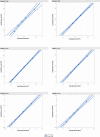The development and validation of a microneutralization assay for the detection and quantification of anti-yellow fever virus antibodies in human serum
- PMID: 40035587
- PMCID: PMC11960057
- DOI: 10.1128/spectrum.03348-24
The development and validation of a microneutralization assay for the detection and quantification of anti-yellow fever virus antibodies in human serum
Abstract
The plaque reduction neutralization test (PRNT) has been used widely for the detection and quantitation of yellow fever (YF) virus-neutralizing antibodies in human serum; however, it is labor-intensive and challenging to adapt to high-throughput clinical testing needed for vaccine licensure. Here, we describe the development and validation of a new Vero cell-based YF microneutralization (MN) assay, with immunostaining readout, for the detection and quantification of YF virus-neutralizing antibodies in human serum. Comparison of neutralizing antibody titers measured with the YF MN assay versus the historical YF PRNT, based on a 50% reduction in plaque counts (PRNT50), demonstrated 100% serostatus agreement at a titer of 10 (1/dil) in participants with a history of YF vaccination. For validation, intra-assay precision (repeatability), intermediate precision, dilutional accuracy, linearity, specificity, upper limit of quantitation (ULOQ), and lower limit of quantitation (LLOQ) were assessed. The YF MN assay demonstrated suitable intra-assay precision (repeatability) and intermediate precision of 36% and 54%, respectively, with an ULOQ of 10,240. At the lower end of detection, repeatability and intermediate precision were 38% and 41%, respectively, with a LLOQ of 10 (1/dil). Suitable dilutional accuracy, linearity, and specificity across orthoflaviviruses (dengue virus, Japanese encephalitis virus, and Zika virus) and serum matrices (hemolytic, lipemic, and icteric) were also demonstrated. Overall, these promising results led the Center for Biologics Evaluation and Research to confirm the suitability of the validated YF MN assay for the detection and quantification of YF virus-neutralizing antibodies.
Importance: With increased globalization and shifting climate patterns, yellow fever (YF) is re-emerging as a global threat. At present, vaccination remains the most effective prevention strategy. This study describes the development and validation of a new YF microneutralization (MN) assay for the detection and quantification of YF virus-neutralizing antibodies in human serum that offers increased throughput compared with the current standard assay. Overall, the YF MN assay demonstrated acceptable intra-assay precision (repeatability), intermediate precision, dilutional accuracy, linearity, and specificity and is suitable for the detection of YF virus-neutralizing antibodies. Further, the Center for Biologics Evaluation and Research (CBER) supports the use of the YF MN assay in the licensure of candidate YF vaccines.
Keywords: assay development; assay validation; microneutralization assay; neutralizing antibodies; orthoflavivirus; yellow fever virus.
Conflict of interest statement
K.F., P.L., R.B., R.G., I.O., and L.D. are employees of Sanofi and may hold shares and/or stock options in the company. L.Z. and J.H. were employed by Sanofi at the time of this study.
Figures


Similar articles
-
Performance assessment and validation of a plaque reduction neutralization test (PRNT) in support to yellow fever diagnostic and vaccine clinical trials.J Med Virol. 2023 Apr;95(4):e28700. doi: 10.1002/jmv.28700. J Med Virol. 2023. PMID: 36951314
-
FluoRNT: A robust, efficient assay for the detection of neutralising antibodies against yellow fever virus 17D.PLoS One. 2022 Feb 9;17(2):e0262149. doi: 10.1371/journal.pone.0262149. eCollection 2022. PLoS One. 2022. PMID: 35139078 Free PMC article.
-
IMMUNO-COV v2.0: Development and Validation of a High-Throughput Clinical Assay for Measuring SARS-CoV-2-Neutralizing Antibody Titers.mSphere. 2021 Jun 30;6(3):e0017021. doi: 10.1128/mSphere.00170-21. Epub 2021 Jun 2. mSphere. 2021. PMID: 34077262 Free PMC article.
-
Immunogenicity and duration of protection after yellow fever vaccine in people living with human immunodeficiency virus: a systematic review.Clin Microbiol Infect. 2021 Jul;27(7):958-967. doi: 10.1016/j.cmi.2021.03.004. Epub 2021 Apr 1. Clin Microbiol Infect. 2021. PMID: 33813107
-
Laboratory evaluation of RealStar Yellow Fever Virus RT-PCR kit 1.0 for potential use in the global yellow fever laboratory network.PLoS Negl Trop Dis. 2022 Sep 6;16(9):e0010770. doi: 10.1371/journal.pntd.0010770. eCollection 2022 Sep. PLoS Negl Trop Dis. 2022. PMID: 36067233 Free PMC article. Review.
References
-
- Simon LV, Hashmi MF, Torp KD. 2024. Yellow Fever, StatPearls, Treasure Island (FL) ineligible companies. Disclosure: Muhammad Hashmi declares no relevant financial relationships with ineligible companies. Disclosure: Klaus Torp declares no relevant financial relationships with ineligible companies.
-
- Postler TS, Beer M, Blitvich BJ, Bukh J, de Lamballerie X, Drexler JF, Imrie A, Kapoor A, Karganova GG, Lemey P, Lohmann V, Simmonds P, Smith DB, Stapleton JT, Kuhn JH. 2023. Renaming of the genus Flavivirus to Orthoflavivirus and extension of binomial species names within the family Flaviviridae. Arch Virol 168:224. doi:10.1007/s00705-023-05835-1 - DOI - PubMed
-
- Centers for Disease Control and Prevention . 2024. Yellow fever. Available from: https://archive.cdc.gov/#/details?url=https://www.cdc.gov/globalhealth/n.... Retrieved 12 Feb 2024.
-
- World Health Organization . 2023. Yellow fever. Available from: https://www.who.int/en/news-room/fact-sheets/detail/yellow-fever. Retrieved 12 Feb 2024.
Publication types
MeSH terms
Substances
LinkOut - more resources
Full Text Sources

